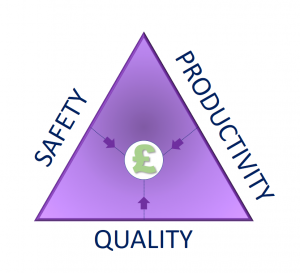Good safety is good business.
 The motive force behind capitalism is the pursuit of profits. This is what drives businesses to do what they do. At a conference yesterday, a very bright and successful man, who runs an aluminium smelter in Dubai, said that he tells his team “we are not in the business of making aluminium, we are in the business of making money”. Such a simple yet effective statement. Profit isn’t a dirty word. Yet so often we see this as a taboo subject. This is why we go into business, and so long as we internalise all our costs (we could have a week long discussion on that point!) we should be proud of the profit we make. It is our key performance indicator of success.
The motive force behind capitalism is the pursuit of profits. This is what drives businesses to do what they do. At a conference yesterday, a very bright and successful man, who runs an aluminium smelter in Dubai, said that he tells his team “we are not in the business of making aluminium, we are in the business of making money”. Such a simple yet effective statement. Profit isn’t a dirty word. Yet so often we see this as a taboo subject. This is why we go into business, and so long as we internalise all our costs (we could have a week long discussion on that point!) we should be proud of the profit we make. It is our key performance indicator of success.
At some point, if we continue along this line of discussion, a voice in your head will interrupt and say, no, we must put people before profit, and keeping people safe must be our number one priority. Indeed, when I was fresh out of university I interviewed to become a Health & Safety Inspector with the British Health & Safety Executive, and they asked me to explain the largest paradox of health & safety in business. I offered some response or other and was told by my interviewers that the paradox was that the objective of private enterprise is to make money and safety is a cost which reduces profit. I told them that I couldn’t disagree more and went off to work in the power industry instead.
The moment we start to think that protecting people at work is contrary to the objective of making profit we reduce our ability to make money.
From time to time, we are faced with decisions where we could take an increased risk that would lead to saving time and money. However, this is only true if you get away with taking the risk in the first place. If however, the loss you are risking is actually realised, your ability to save time and money has gone and instead you will be looking at huge cost and delays. Anyone who has been involved in a health and safety incident will know, they cost time, money and reputation. So even if your heart is stony and the personal cost doesn’t motivate you, the loss of profit will.
Show me a dirty, dangerous manufacturing plant and I will show you a plant that doesn’t reach its true profit potential. Well maintained, clean, safe sites make more money.
So Safety, Quality and Productivity are not mutually exclusive. Spending money on safety does not reduce your productivity, it increases it. Likewise, if you focus on doing a safe job it will turn out to be a better job where time is taken to get things right. Just like an accident, rework costs time and money too. So if you work at a site where the manager says we can’t afford a safety measure like that, make it your mission to convince them that they can’t afford not to.
 Like any business investment, we will of course come up against diminishing returns. No one is saying that the more you spend on safety the more money you will make. This is not the point being made here. The point is, talking about making money and sharing your profit numbers does not mean you don’t care about safety. Likewise, promoting good safety and investing in good, well planned risk mitigation does not mean you are not interested in profit. The area to address is the behavioural one. If there is a view at your place of work that safety expenditure is a necessary evil and doesn’t support profit, then any managerial talk of increasing profit can be taken as a message to cut corners on safety. So share the message that Safety, Quality and Productivity are complementary activities. Energy and money spent on one side of the triangle supports the other two. Be clear in this message and don’t be afraid to re-iterate that you never expect anyone to risk personal safety.
Like any business investment, we will of course come up against diminishing returns. No one is saying that the more you spend on safety the more money you will make. This is not the point being made here. The point is, talking about making money and sharing your profit numbers does not mean you don’t care about safety. Likewise, promoting good safety and investing in good, well planned risk mitigation does not mean you are not interested in profit. The area to address is the behavioural one. If there is a view at your place of work that safety expenditure is a necessary evil and doesn’t support profit, then any managerial talk of increasing profit can be taken as a message to cut corners on safety. So share the message that Safety, Quality and Productivity are complementary activities. Energy and money spent on one side of the triangle supports the other two. Be clear in this message and don’t be afraid to re-iterate that you never expect anyone to risk personal safety.
In order to indicate how important safety is, we often put this item first on our meeting agendas. While this makes sense, think about the messaging affect of this. Consider a daily planning meeting in a factory or process plant. We discuss safety at the top of the meeting. We then talk about the day’s planned work, we may talk about the gross margin, order levels, overnight sales, maintenance issues and then the production schedule. What do the people leaving that meeting have in their minds as they go to work? Perhaps their lasting memory is the last thing they heard, the schedule. Try finishing each planning meeting with a safety message that supports the notion that safe working comes first. Make sure that your team are left in no doubt that above all else the safety of them and others is the primary concern. That way your team approaches their day with this message ringing in their ears. After all, doing a safe job is good for business.
NB I went to university a long, long time ago! The Health and Safety Executive now promote the view that safety is a contributor to profit.
